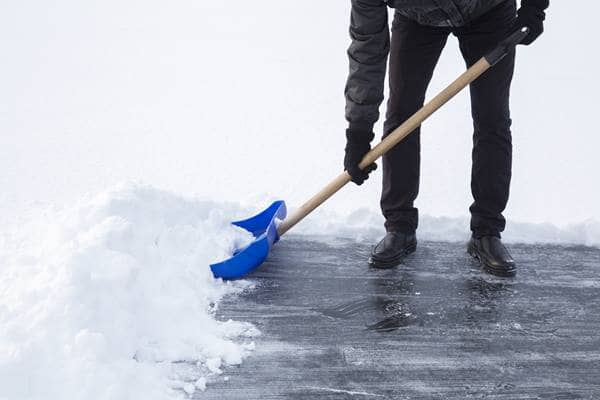
By: Mike Huss
Risk Solutions Consultant
Winter weather presents hazards including slippery roads and surfaces, strong winds, and environmental cold. Employers can prevent illnesses, injuries, or fatalities, by controlling these hazards in workplaces impacted by winter weather. Snow removal operations can result in serious injuries or fatalities—particularly while removing ice or snow from rooftops and other building structures such as decks.
Shoveling snow
Shoveling snow can be a strenuous activity, particularly because cold weather can be taxing on the body. There is a potential for exhaustion, dehydration, back injuries, or heart attacks. During snow removal, in addition to following the tips for avoiding cold stress, such as taking frequent breaks in warm areas, there are other precautions workers can take to avoid injuries. Workers should warm-up before the activity, scoop small amounts of snow at a time, and, where possible, push the snow instead of lifting it. The use of proper lifting technique is necessary to avoid back and other injuries when shoveling snow: keep the back straight, lift with the legs, and do not turn or twist the body.
Using powered equipment
Snow blowers commonly cause lacerations or amputations when operators attempt to clear jams with the equipment turned on. Never attempt to clear a jam by hand. First, turn the snow blower off and wait for all moving parts to stop, and then use a long stick to clear wet snow or debris from the machine. Keep your hands and feet away from moving parts. Refuel a snow blower prior to starting the machine; do not add fuel when the equipment is running or when the engine is hot.
Clearing snow from roofs and working at heights
Evaluate snow removal tasks for hazards and plan how to do the work safely. Be aware of the potential for unexpected hazards due to the weather conditions, for example, layers of ice can form as the environmental temperature drops, making surfaces even more slippery. A surface that is weighed down by snow must be inspected by a competent person to determine if it is structurally safe to access it, because it may be at risk of collapsing. Snow-covered rooftops can hide hazards such as skylights that workers can fall through. Electrical hazards may also exist from overhead power lines or snow removal equipment.
Winter driving
Although employers cannot control roadway conditions, they can promote safe driving behavior by ensuring workers recognize the hazards of winter weather driving, e.g., driving on snow/ice-covered roads, being properly trained for driving in winter weather conditions, and holding licenses (as applicable) for the vehicles they operate.
Preventing slips on snow and ice
To prevent slips, trips, and falls, employers should clear walking surfaces of snow and ice and spread deicer as quickly as possible after a winter storm. In addition, the following precautions will help reduce the likelihood of injuries:
Wear proper footwear when walking on snow or ice. A pair of insulated and water-resistant boots with good rubber treads is a must for walking during or after a winter storm. Keeping a pair of rubber overshoes with good treads which fit over your street shoes is a good idea during the winter months.
Take short steps and walk at a slower pace so you can react quickly to a change in traction when walking on an icy or snow-covered walkway.
Source: Occupational Safety and Health Administration (OSHA)
Snowplow safety
- Use caution when following, passing, or approaching snow removal equipment.
- Drive a safe distance behind snowplows. Plows often travel slower than other vehicles to remove snow, apply sand and liquid anti-icers, and assist stranded vehicles.
- Before attempting to pass snow removal equipment, check direction of snow discharge to avoid snow and debris thrown from equipment. Remember that plows are wider than most vehicles, and portions of the plow and blade may be obscured by blowing snow.
- Don’t crowd the plow.
- Only pass snow removal vehicles when a safe, legal passing area is available and adequately clear of snow and/or treated with salt and sand.
- Don’t travel beside a snowplow. They can shift sideways after hitting snowpacks or drifts.
- When a plow approaches you, allow the plow room to operate by reducing speed and moving to the right side of the road if there is room to safely do so.
- Do not brake with unnecessary sudden movements when in front of a snowplow - plows cannot stop as quickly as an automobile.
- Don’t drive through white-out conditions caused by swirling snow around a snowplow. Safely pull to the side or slow to allow visibility to improve.
- Remember that a snowplow operator’s field of vision is restricted. You may see them, but they may not see you.
Source: Nevada Department of Transportation

